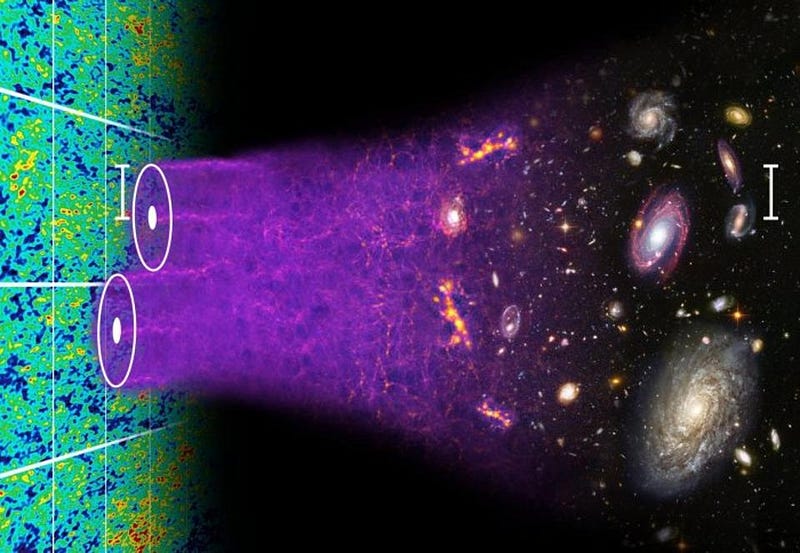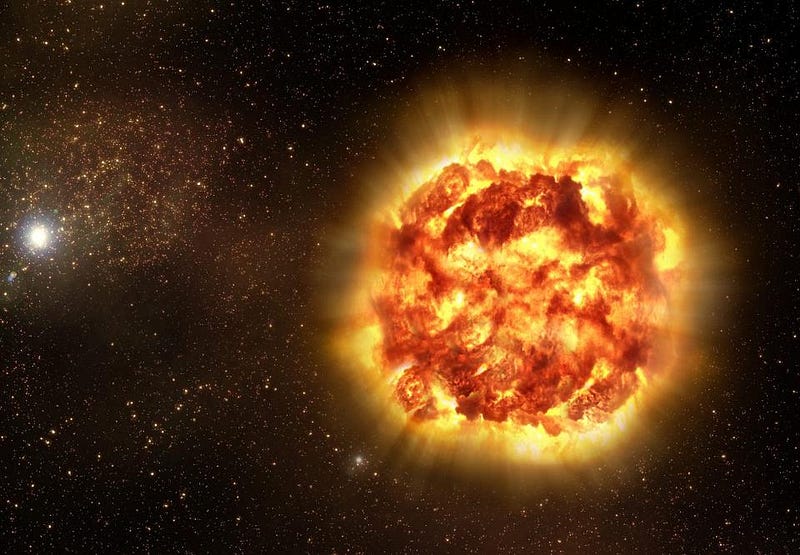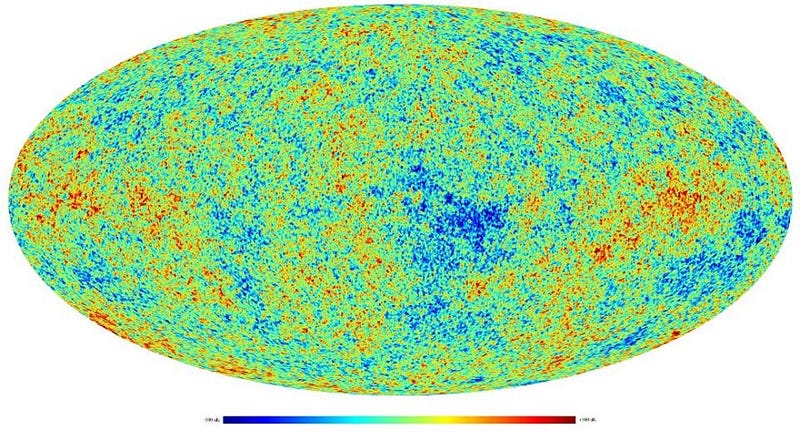Ask Ethan: Is there a center of the Universe?

If the Big Bang happened and everything is moving away from us, where’s the center?
“I want to stand as close to the edge as I can without going over. Out on the edge you see all the kinds of things you can’t see from the center.”
–Kurt Vonnegut
Our Universe began from a Big Bang, but that doesn’t mean we picture it correctly. Most of us think of it as an explosion: where everything started out hot and dense all at once, then expanded and cooled as the different fragments sped away from one another. But as tempting as that picture is, it isn’t correct at all. This led Jasper Evers to ask a very good question:
I am wondering how there isn’t a centre of the universe and how the cosmic background radiation is [equally] far away everywhere we look. It seems to me that when the universe expands … there should be a place where it started expanding.
Let’s think about the physics of an explosion for a moment, and what our Universe would be like if it began from one.

An explosion begins at a point, and expands outwards rapidly. The fastest-moving material moves outwards the most rapidly, and hence spreads out the fastest. The farther away you are from the center of the explosion, the less material will reach you. The energy density goes down as time goes on everywhere, but it goes down faster farther away from the explosion, because the energetic material is more sparse at the outskirts. No matter where you are, you’ll always be able — assuming you’re not destroyed — to reconstruct the center of the explosion.

But this isn’t the Universe we see. The Universe looks the same at large and short distances: the same densities, the same energies, the same galaxy counts, etc. The objects far away, moving away from us at greater speeds, don’t appear to be the same age as the objects closer to us which move at slower speeds; they appear younger. There aren’t fewer objects at great distances, but more of them. And if we take a look at how everything is moving in the Universe, we find that despite the fact that we can see out for tens of billions of light years, the reconstructed center lands right on us.

Does that mean we, out of all the trillions of galaxies in the Universe, happened to be at the center of the Big Bang? And that the initial ‘bang’ was configured in just such a way — with irregular, inhomogeneous densities, energies, ‘start times’ and a mysterious 2.7 K glow — to conspire so that we’re at the center? What an ungenerous Universe it would be if that were the case: to configure itself in this incredibly unrealistic way at the start.

Instead, what General Relativity predicts is not an explosion, but an expansion. A Universe that begins from a hot, dense state has its very fabric expand. There’s a misconception that this would have started from a single point; it isn’t so! Instead, there’s a region that has these properties — filled with matter, energy, etc. — and then the Universe evolves under the laws of gravity.
It has similar properties everywhere, including density, temperature, number of galaxies, etc. If we were to look out, though, what we’d see would be evidence of an evolving Universe. Because the Big Bang happened everywhere at once a finite amount of time ago in a region of space, and that region is all that’s observable to us, when we look out from our vantage point, we’re seeing a region of space that’s not so different from our own position in the past.

Galaxies whose light took a billion years to get here appear as they were a billion years ago; galaxies whose light took ten billion years to get here appear as they were ten billion years ago! 13.8 billion years ago, the Universe was dominated by radiation, not matter, and when the Universe first formed neutral atoms, that radiation still persists, having been cooled and redshifted due to the expanding Universe. What we perceive as the Cosmic Microwave Background is not only the leftover glow from the Big Bang, but this radiation is observable from any location in the Universe.

There isn’t necessarily a center to the Universe; what we call a “region” of space where the Big Bang occurred could be infinite. If there is a center, it could literally be anywhere and we wouldn’t know; the part of the Universe we can observe is insufficient to reveal that information. We’d need to see an edge, a fundamental anisotropy (where different directions appear different) in temperatures and galaxy counts, and our Universe, on the largest scales, really does look the same everywhere and in all directions.

There isn’t a place where the Universe started expanding because of the Big Bang; there’s a time when the Universe began expanding. That’s what the Big Bang is: a condition affecting the entire observable Universe at a specific moment. It’s why looking to greater distances in all directions means looking back in time. It’s why all directions appear to have roughly uniform properties. And it’s why our story of cosmic evolution can be traced back as far as our observatories can see.

Perhaps the Universe has a finite shape and a finite size, but if it does, that information is inaccessible to us. The portion of the Universe observable to us is finite, and that information isn’t contained within it. If you think of the Universe as a balloon, a loaf of bread or any other analogy you like, remember that you’re only able to access a tiny part of the actual Universe; what’s observable to us is only a lower limit on what’s out there. It could be finite, it could be infinite, but what we’re sure of is that it’s expanding, it’s getting less dense, and the farther away we look, the farther back in time we’re able to see. As astrophysicist Katie Mack says:
The Universe is expanding the way your mind is expanding. It’s not expanding into anything; you’re just getting less dense.
Submit your Ask Ethan questions to startswithabang at gmail dot com!
This post first appeared at Forbes, and is brought to you ad-free by our Patreon supporters. Comment on our forum, & buy our first book: Beyond The Galaxy!





